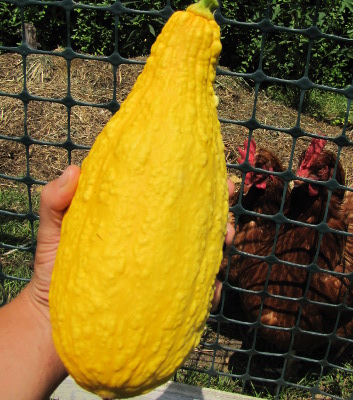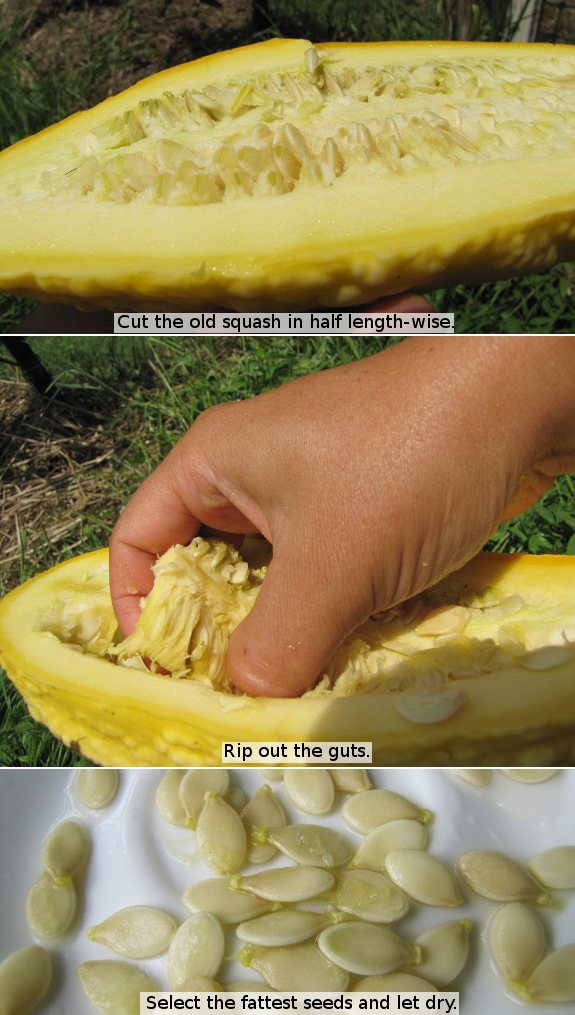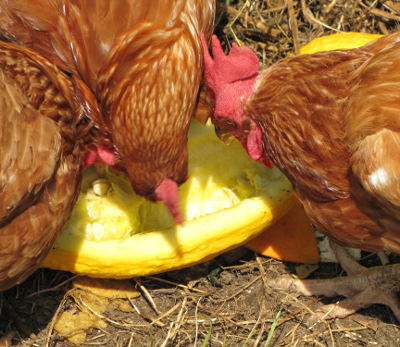
What to do with monster squash
 The joke goes that July is
the only month when you have to lock your car in
[insert the name of your rural county here] or you'll return to find
it full of zucchini. Previously, I've rolled my eyes and held out
my hand when told that tale of garden bounty, but for the first time in
2012, succession planting and variety selection have allowed us to
defeat the squash
vine borer and we're
drowning under an ever expanding pile of summer squash.
The joke goes that July is
the only month when you have to lock your car in
[insert the name of your rural county here] or you'll return to find
it full of zucchini. Previously, I've rolled my eyes and held out
my hand when told that tale of garden bounty, but for the first time in
2012, succession planting and variety selection have allowed us to
defeat the squash
vine borer and we're
drowning under an ever expanding pile of summer squash.
We've done our best to
eat the bounty (and have at least one great new recipe to share), have dried
masses of the squash for the winter, but the inevitable finally
happened --- monster squash! In my gourmet
opinion, a monster squash is any summer squash where the seeds have
become more than a thin line within the flesh. There are so many
tender, young squash competing for my attention that I figure a monster
squash isn't worth my culinary time.
Of course, the
permaculture side of me isn't willing to let even a monster squash go
to waste, and once I started thinking up purposes for our one monster
squash, I wished I had a few dozen more. Here are my top ideas:

- Save the seeds.
Summer squash are on the easy
seed-saving list. Just let your monster squash keep growing
for an extra week or two until the seeds inside are well developed, cut
the squash open and carefully pull the seeds out, choose the fattest
seeds that didn't get injured, then let them dry before putting the
seeds away for next year. The only trouble you'll get into is if
you're growing a hybrid or if more than one variety of Cucurbita pepo is blooming in
your garden at the same time.
 Feed the chickens, pig, goats,
etc. Monster vegetables are good to pass off on your
barnyard animals, especially if the flock doesn't have access to much
vegetation. If you're feeding monster cucurbits to chickens, be
sure to cut the vegetable in half or into smaller sections and drop it
cut-side-up in the pasture.
Feed the chickens, pig, goats,
etc. Monster vegetables are good to pass off on your
barnyard animals, especially if the flock doesn't have access to much
vegetation. If you're feeding monster cucurbits to chickens, be
sure to cut the vegetable in half or into smaller sections and drop it
cut-side-up in the pasture.
- Feed the worms. If you only have a small, under-the-sink worm bin, you'll have to be careful not to overload it. But outside bins can handle lots and lots of monster squash. For fastest results, cut the squash into chunks or throw it in the blender before feeding.
- Compost it. The
last resort with any kind of organic matter, of course, is to toss it
in the compost pile. You might end up with some volunteer squash
next year if your pile doesn't get hot enough, but won't have any other
problems.
I saved the seeds from
my monster crookneck squash and then gave the remains to the old girls,
who asked for more. What do you do with monster squash?
Want more in-depth information? Browse through our books.
Or explore more posts by date or by subject.
About us: Anna Hess and Mark Hamilton spent over a decade living self-sufficiently in the mountains of Virginia before moving north to start over from scratch in the foothills of Ohio. They've experimented with permaculture, no-till gardening, trailersteading, home-based microbusinesses and much more, writing about their adventures in both blogs and books.
Want to be notified when new comments are posted on this page? Click on the RSS button after you add a comment to subscribe to the comment feed, or simply check the box beside "email replies to me" while writing your comment.

I purposely overgrow my zucchini to make these family faves. Cut in half, scoop the guts, peel. I chop into something like celery stick shape and size. Then simmer in a big pot with frozen concentrated fruit juice usually mixed 1 can juice to 2 cans water (instead of 3). Add a little citric acid to brighten the flavors. Simmer gently for 30 minutes, then turn off heat and let them sit for a couple hours and absorb the flavors. Then dehydrate overnight. Gummy worms!! I can't keep up with my family's appetite for these.
It's about 1 can of juice per one monster zuc. I stain and reuse the water once, adding another can or two of juice. I typically do 2 circular dehydrator trays per monster.